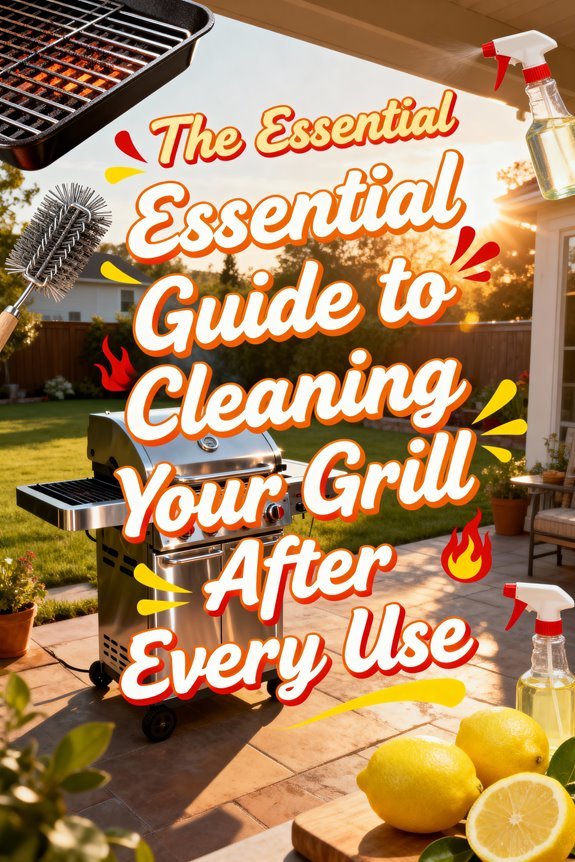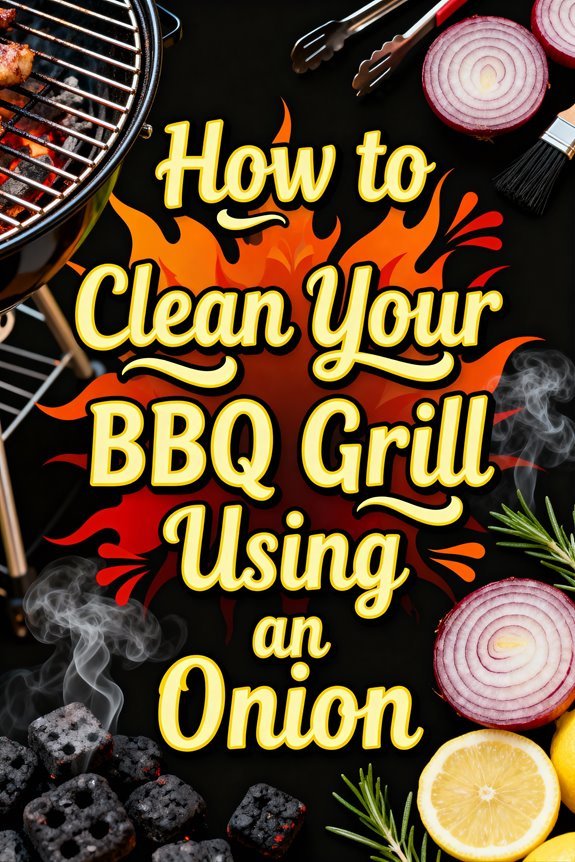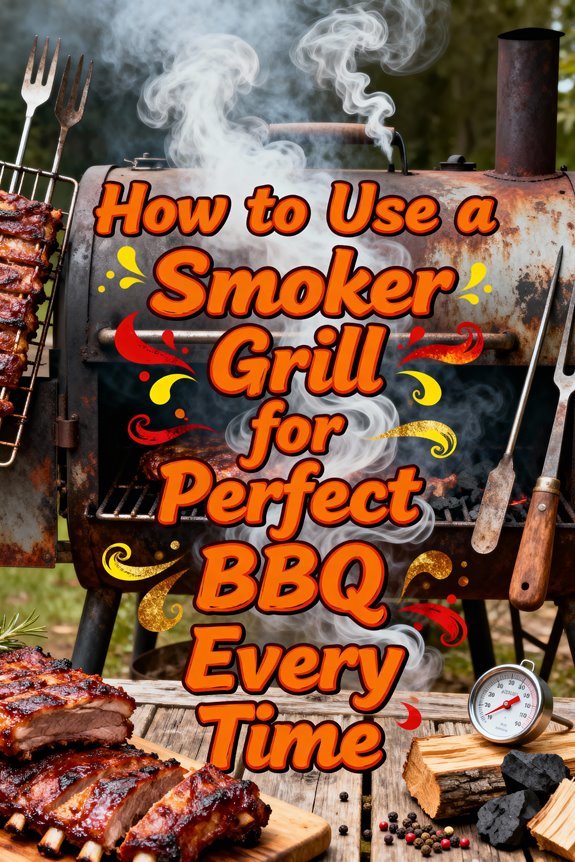Start by unplugging your George Foreman grill and letting it cool completely for safety. Once cool, remove the drip tray and any detachable plates, then wash them with warm, soapy water using a soft sponge. For non-removable plates, use a damp cloth with soapy water to wipe down the grooves, employing a plastic spatula for stubborn residue. Wipe the exterior with a clean, damp cloth and dry thoroughly. Regular cleaning after each use prevents buildup and maintains your grill’s nonstick surface, and there are additional natural solutions and techniques that’ll make this process even more effortless.
Safety First: Unplugging and Cooling Your Grill
Before you begin cleaning your George Foreman Grill, you must prioritize electrical safety by unplugging the appliance from the outlet. Wait until the power indicator light turns off, then grasp the plug firmly and pull straight out—never yank the cord. This proper unplugging technique prevents sparks and cord damage.
Next, allow the grill to cool completely before handling any components. The grill plates and drip tray retain heat longer than the exterior, so patience is essential. Safe handling requires using oven mitts if you must move the grill while it’s partially cooled. Place it on a stable, heat-resistant surface away from flammable materials. Using natural cleaning methods will help preserve your grill’s surface while ensuring safe food preparation. Starting with warm grates makes cleaning more effective as residue is easier to remove.
Never attempt to clean hot surfaces, as this risks severe burns and injury. Complete cooling guarantees safe, effective cleaning. Avoid immersion of cord, plugs, or appliance in water or other liquids during the cleaning process to prevent electrical shock.
Preparing the Grill Surface for Cleaning
Once your grill has cooled completely, open the lid fully and secure it in position to create a stable workspace. Before applying any cleaning agents, you’ll need to address surface debris. Use a soft brush or cloth to sweep away loose food particles and crumbs that accumulated during cooking. This preliminary step prevents you from spreading debris around when you begin wet cleaning.
Never apply water or cleaners directly onto the grill plates themselves. Instead, apply cleaning solutions to your cloth or sponge first. This protects electrical components from moisture damage and prevents potential hazards. Work in a well-lit area to ensure you don’t miss any spots during the cleaning process. Using a brush with heat-resistant sponge material rather than wire bristles provides safer and more effective cleaning results. A mixture of baking soda paste can help loosen stubborn grease buildup on the grill surface.
For easier future cleaning, consider placing lightly oiled aluminum foil on the grill temperature surfaces before cooking. This simple barrier minimizes residue adherence considerably.
[affiai keyword=”grill cleaning brushes and tools” template=”carousel” count=”3″
Cleaning Removable Plates and Drip Trays
When your George Foreman grill features removable plates, you’ll find cleaning becomes considerably easier than working with fixed surfaces. Start by allowing the grill to cool completely, then release the plates using the quick-release buttons or locking mechanism. Wash them with warm, soapy water and a soft sponge, avoiding abrasive pads that damage nonstick coatings. For stubborn residue, soak the plates briefly before scrubbing. Similar to gas grills, using mild detergent solutions helps preserve the coating while effectively removing grease. Proper plate maintenance requires thorough rinsing and immediate drying with a lint-free cloth. Just as with Weber grills, regular brushing before and after use helps prevent buildup of carbonized grease.
For effective tray care, remove the drip tray after each use and wash it by hand or in the dishwasher’s upper rack. Use a bottle brush to reach corners where grease accumulates. Verify that the tray is securely placed once you reinsert it into the grill. Rinse completely and dry before reinserting. Inspect all components before reassembly to verify no residue remains.
Tackling Non-Removable Grill Plates
Although non-removable grill plates demand more attention than their detachable counterparts, they’ll remain in excellent condition when you follow a systematic cleaning approach. First, unplug your grill and let it cool for at least 15 minutes. Use a plastic or silicone spatula to remove loose debris while plates are warm. These cleaning techniques protect the non-stick coating from damage. Heating the grates makes food particles easier to remove.
Next, prepare warm, soapy water and apply it with a damp sponge—never pour water directly onto the grill. Gently scrub with a nylon pad, focusing on grooves where food accumulates. For particularly stubborn bits, use a plastic scraper to dislodge food particles without damaging the surface. Similar to maintaining outdoor grills, natural degreasers can help break down tough residue. Rinse your sponge frequently for effective residue removal.
Finally, wipe plates with a clean, damp cloth to eliminate soap residue, then dry thoroughly. These maintenance tips prevent rust and guarantee your grill’s longevity.
Wiping Down the Exterior and Hard-to-Reach Areas
While the grill plates receive most of your attention during cleaning, the exterior surfaces and hidden areas require regular maintenance to keep your George Foreman Grill functioning properly and looking its best.
Start by wiping exterior surfaces with a warm, damp cloth to remove grease and food particles, then follow with a dry cloth to prevent streaks. Similar to maintaining optimal airflow control, proper cleaning helps ensure consistent heating performance. Avoid abrasive cleaners or steel wool that damage the finish. Using plastic utensils only helps prevent scratches that can trap food debris and make cleaning harder.
For hinge cleaning, open the lid fully and use cotton swabs or small brushes dipped in soapy water to reach tight crevices. Clean the underside of the hood where grease accumulates, but avoid excessive moisture near electrical components. Use mild soap mixed with water for the best cleaning results without damaging surfaces.
Remove and wash the drip tray after each use, drying it thoroughly before reinserting. Always unplug the grill and verify it’s cool before cleaning.
[affiai keyword=”grill cleaning supplies and brushes” template=”carousel” count=”3″
Smart Cleaning Hacks: The Aluminum Foil Method
If you’re looking to minimize post-cooking cleanup, the aluminum foil method offers a practical shortcut that many George Foreman Grill owners swear by. Before preheating, line both upper and lower plates with lightly oiled foil. The foil catches drippings and prevents food from contacting the grill surface directly, eliminating baked-on residue.
The foil benefits include dramatically reduced scrubbing time and protection of grill grooves from trapped particles. After cooking, you’ll simply remove and discard the foil. Similar to traditional BBQ grills, warm grates clean easier than cold surfaces when removing residue. Just like with outdoor charcoal grilling, proper preheating helps achieve even cooking temperatures and better results.
However, consider the foil drawbacks: this method lacks official manufacturer endorsement, and wrapping electric cooking surfaces carries potential safety risks. The foil may also alter heat distribution and cooking performance. Additionally, frequent single-use foil creates environmental waste. If you choose this approach, guarantee proper application and never cover heating elements directly. The foil can be reused for storing leftovers instead of discarding, reducing waste and extending its utility beyond a single cooking session.
[affiai keyword=”aluminum foil for electric grills” template=”carousel” count=”3″
Natural Solutions for Stubborn Grease and Stains
When baked-on grease and stubborn stains resist standard cleaning methods, natural household ingredients provide effective solutions without harsh chemicals. Create a powerful paste by combining baking soda with water, then apply it directly to greasy areas. For tougher spots, mix baking soda with white vinegar to form a fizzing paste that breaks down residue. You’ll find that an olive oil and salt rub works exceptionally well on persistent stains—the salt provides abrasive power while oil loosens debris. Cut an onion in half and use its natural cleaning oils to remove carbonized residue from the grill surface. Working with the grain direction helps prevent unwanted scratches and maintains the grill’s appearance.
Apply lemon juice to remove discoloration, leveraging its natural bleaching properties. When using these natural stain removers, employ effective scrubbing techniques with nylon pads or soft brushes to protect the non-stick coating. For sticky residue, cornstarch mixed with water creates an ideal cleaning solution. Always scrub gently using non-metallic tools. Consider using steam as a natural cleaning aid to help lift grease effectively from your grill plates.
[affiai keyword=”natural cleaning products for grease removal” template=”carousel” count=”3″
Essential Maintenance Tips for Long-Lasting Performance
Beyond tackling tough stains and buildup, maintaining your George Foreman grill requires consistent care practices that prevent problems before they start. Just as with Weber grills, high heat cleaning helps loosen stubborn residue for easier removal. For safer scrubbing without wire brushes, try using aluminum foil balls as an effective natural cleaner. Implementing preventative practices greatly reduces cleaning effort. Always unplug and cool your grill completely before handling—this prevents burns and thermal shock that warps plates. Clean removable plates and drip trays after every use to avoid grease accumulation and fire hazards. For non-removable plates, wipe surfaces while warm with a damp cloth.
Establish a regular maintenance frequency by inspecting power cords, plates, and ventilation areas for damage or debris. Regular cleaning helps maintain grill performance and prevents long-term issues. Store your grill in a dry location to prevent moisture damage. Consider using aluminum foil liners for easier cleanup, and avoid cooking overly sticky foods directly on surfaces. Following a routine maintenance schedule extends your grill’s lifespan and guarantees peak performance.







